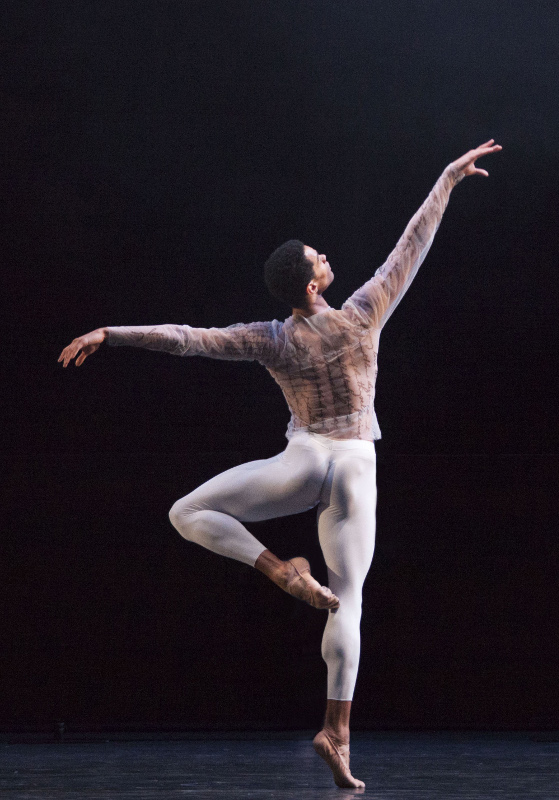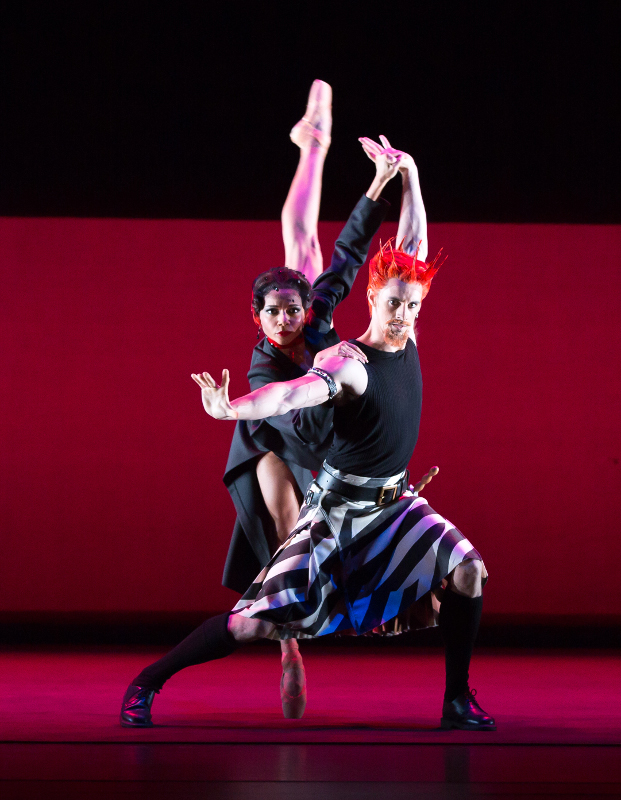Shakespeare has always been a fertile source of inspiration for story ballets. Plays which exist in multiple dance versions include Romeo and Juliet, The Tempest, A Midsummer Night's Dream, The Taming of the Shrew and Hamlet, while Shakespeare sources have often moved choreographers to their best work: Ashton's Dream, MacMillan's Romeo and Juliet, and Christopher Wheeldon's recent Winter's Tale for the Royal Ballet are all highlights of their respective creators' oeuvres. Birmingham Royal Ballet has done the obvious thing in this anniversary year by mounting several of these story ballets, including a new Tempest, but this triple bill at Sadler's Wells is their contribution to a more creative, non-literal capturing of Shakespeare's works in dance.
Jessica Lang's Wink – created for the company and premiered earlier this year – takes the prize for formal ingenuity. It is a response to the sonnets, and goes far beyond simply emotional or narrative resonances. Wink's structure in a series of quartets and a duet mimics a sonnet's quatrains and couplets, for example, while the rotating of the black and white boards which constitute the set might be interpreted as a visual representation of iambs, the metrical "feet" which make up a sonnet's lines. Lang's neo-classical choreographic style and adherence to balletic structural conventions provide a much better response to the tightly regulated sonnet form than the sub-Pina Bausch tanztheater emoting chosen by Christian Spuck for his ballet on the same theme.
 Lang by no means neglects the emotional or the narrative content of the sonnets, but she rightly abstracts and distills it rather than seeking literal representation. Brandon Lawrence (pictured right), a dancer of noble bearing and gorgeous physique (I would love to see him do Siegfried or Albrecht), takes the most bard-like role: during the recitation of five sonnets, mostly about time, memory and loss, he dances solos which combine classical ballet's refined gestural conventions with a more expressionistic style to perfectly sonnet-like effect, both raw with emotion and formally contained. Lawrence also gets a well-constructed male-male pas de deux with blond Lewis Turner, surely recalling Shakespeare's Fair Youth. The more playful aspect of the sonnets is picked up on in several splendid petit allegro sections towards the end, while their romantic mode is captured in the first quartet, a rather soupy double duet.
Lang by no means neglects the emotional or the narrative content of the sonnets, but she rightly abstracts and distills it rather than seeking literal representation. Brandon Lawrence (pictured right), a dancer of noble bearing and gorgeous physique (I would love to see him do Siegfried or Albrecht), takes the most bard-like role: during the recitation of five sonnets, mostly about time, memory and loss, he dances solos which combine classical ballet's refined gestural conventions with a more expressionistic style to perfectly sonnet-like effect, both raw with emotion and formally contained. Lawrence also gets a well-constructed male-male pas de deux with blond Lewis Turner, surely recalling Shakespeare's Fair Youth. The more playful aspect of the sonnets is picked up on in several splendid petit allegro sections towards the end, while their romantic mode is captured in the first quartet, a rather soupy double duet.
The contrasts of mood between the three quatrains also struck me as potential echoes of Shakespeare's three main dramatic modes: tragedy in the first, lyric and darkly lit one; comedy in the second, sunny one; and history in the final one with its muscular lads and martial rhythm. Jakub Ciupinski's spare score of strings suits all three moods without overpowering any, and its gently insistent rhythm captures the feeling of Shakespeare's meter, while Peter Teigen's lighting plays with shadows, silhouettes, and black and white: picking up Mimi Lien's revolving boards, obviously, but also perhaps gesturing at the Dark Lady/Fair Youth contrast. The beauty of this ballet is that it generously provokes such reflection without dictating any one interpretation, while still being a fine piece of dance on its own terms.
José Limón's The Moor's Pavane (1949) is much more literal than Wink, being an explicitly narrative take on Othello, but like Lang, Limón understood the importance of structure when responding to Shakespeare: his piece is built on the form of a pavane, and it is within that framework that the four characters (not named as such, but Othello, Desdemona, Iago, and Emilia) enact a distilled version of the play, compelled by the convention of the dance to confront one another in circles of ever-increasing deceit and suspicion. Tyrone Singleton is a compelling Moor, broodingly charismatic in his red velvet, and he was ably supported by Delia Mathews as the Moor's Wife, Iain Mackay as His Friend, and Samara Downs as His Friend's Wife.
 After the spare elegance of Wink and the restraint of The Moor's Pavane, David Bintley's Shakespeare Suite, with its Duke Ellington score and kitschy cariacatures of Shakespeare's iconic couples, is a shock to the system, and not an entirely welcome one. It surely intends to be crowd-pleasing, but several segments feel laboured – Titania and Bottom's frolic is an irritating rather than engaging kind of madcap, and Romeo and Juliet's breathless teenage romance is likewise overdone. The odder ones are more interesting, like predatory Richard III with a Lady Anne who can't resist a bad man, while Céline Gittens's velvety lyricism contributes oodles of class to Lady Macbeth, whose subtly spiked shoulder pads are costume genius (pictured above left, Gittens with Iain Mackay as Macbeth). But the frantic "split-personality" Hamlet with a chorus line of dancers in mesh shirts tried my patience, and the Othello segment shows up woefully after The Moor's Pavane – we see Othello (played by Singleton again), bare-chested with Rasta braids, smother Desdemona, but we don't see his subsequent remorse and self-punishment, which makes the episode feel like a celebration of murder; not cool.
After the spare elegance of Wink and the restraint of The Moor's Pavane, David Bintley's Shakespeare Suite, with its Duke Ellington score and kitschy cariacatures of Shakespeare's iconic couples, is a shock to the system, and not an entirely welcome one. It surely intends to be crowd-pleasing, but several segments feel laboured – Titania and Bottom's frolic is an irritating rather than engaging kind of madcap, and Romeo and Juliet's breathless teenage romance is likewise overdone. The odder ones are more interesting, like predatory Richard III with a Lady Anne who can't resist a bad man, while Céline Gittens's velvety lyricism contributes oodles of class to Lady Macbeth, whose subtly spiked shoulder pads are costume genius (pictured above left, Gittens with Iain Mackay as Macbeth). But the frantic "split-personality" Hamlet with a chorus line of dancers in mesh shirts tried my patience, and the Othello segment shows up woefully after The Moor's Pavane – we see Othello (played by Singleton again), bare-chested with Rasta braids, smother Desdemona, but we don't see his subsequent remorse and self-punishment, which makes the episode feel like a celebration of murder; not cool.
The band under Paul Murphy played the Duke Ellington score with a vengeance, but frankly it was all a little too much for me, a crude comedown after two fine pieces. Bintley's Shakespeare Suite should be retired from the repertory of Bard-inspired dance, but Wink deserves to take its place alongside The Moor's Pavane as a classic of the genre.
- Birmingham Royal Ballet will perform The Tempest at Sadler's Wells 13-15 October and a triple bill of Wink, The Moor's Pavane, and The Dream at the Theatre Royal Plymouth 25-26 October.
- Read more dance reviews on theartsdesk














Add comment